“Be who you are and say what you feel, because those who mind don’t matter and those who matter don’t mind.” Dr. Seuss
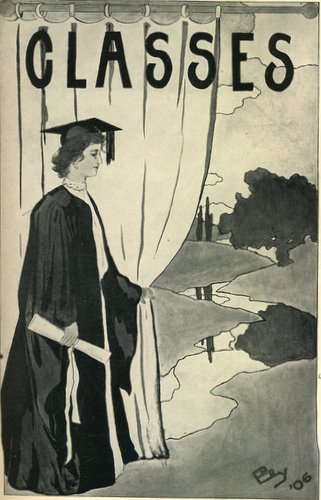
Carey McWilliams’ War Relocation Authority Records Collection
Sixty volumes of newspapers from Japanese American internment camps, examples pictured below, are among the War Relocation Authority records that were assembled by Carey McWilliams, journalist and defender of the rights of minorities, in research for his book, Prejudice (1944).
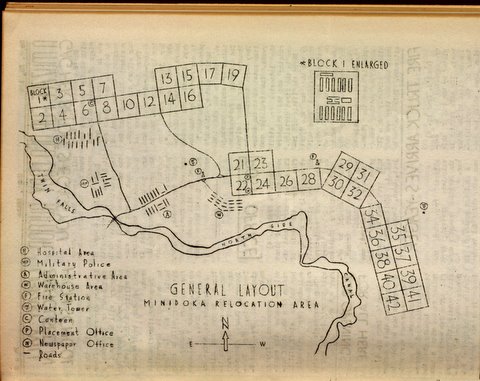
map of the Minidoka Relocation Center in Idaho, from the Minidoka Irrigator
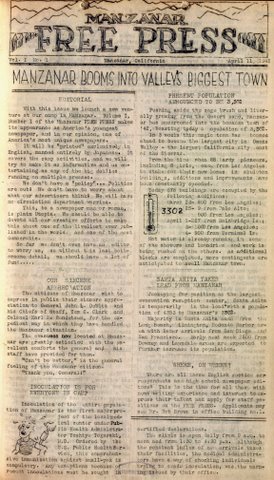
front page of Vol. 1 Issue 1 of the Manzanar Free Press
The War Relocation Authority Records Collection also comprises reports, opinions, books, periodicals, and correspondence between McWilliams and evacuees also features minutes of the Japanese-American Citizen League National Conference, some copies of “Evacuee Speaks”, and newspaper clippings from all over the U.S. reflecting various shades of public opinion on this controversial aspect of American government policy during World War II.
The Collection can be used for research at Special Collections, Honnold/Mudd Library. The finding aid to the collection is found at the Online Archive of California at http://tinyurl.com/28mltka
Sir William Hamilton’s Campi Phlegraei, Observations on the Volcanos of the Two Sicilies as They have been Communicated to the Royal Society of London (1776-1779)
The Campi Phlegraei is a first-hand report which documents the late eighteenth century eruptions of Mount Vesuvius. Written by Sir William Hamilton, the British envoy to the Neapolitan royal court in 1764, the work is named for the area around Naples known locally as the Campi Phlegraei or “flaming fields,” referring to the frequent and violent eruptions of Mount Vesuvius. The area was a popular destination for wealthy travelers undertaking the Grand Tour because of the long history of volcanic activity as well as the classical sites, Pompeii and Herculaneum, which were excavated in 1748 and 1738 respectively.
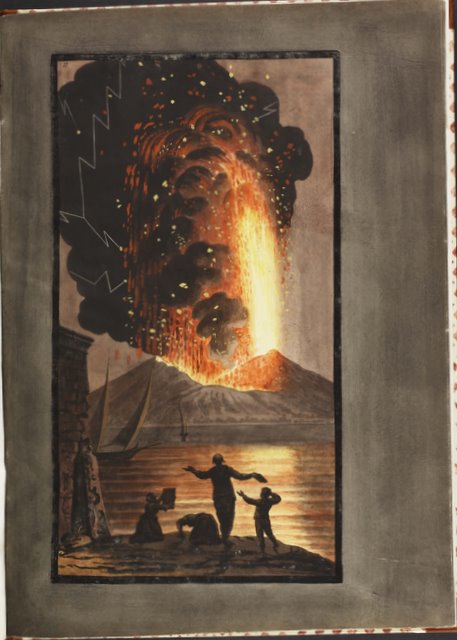
Hamilton was able to observe the volcano from his arrival in Naples on November 17, 1764, through the eruptions which lasted until October 20, 1767. He became a Fellow of the Royal Society and wrote a series of letters describing the activity of the volcano. The letters were to be read aloud at the Society’s meeting and published in its Transactions. The letters make up the text of the Campi Phlegraei. Hamilton engaged the Anglo-Neapolitan artist Peter Fabris to create sketches in situ to illustrate the work. The sketches were reproduced in prints that were hand colored individually by local artists.
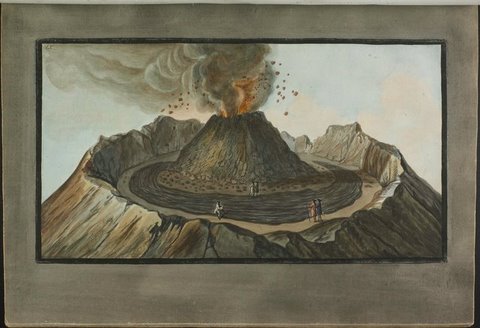
Volume one of the Campi Phlegraei is predominately text with a single plate and a map. Volume two is predominantly plates with textual descriptions. The third book is a supplement to the original two volume work. The supplement was published in 1779 and describes the eruption of Mt. Vesuvius in August 1779. The supplement is composed of letters written to The Royal Society of London and five hand-colored plates illustrating the volcanic activity.
Special Collections copy of the Campi Phlegraei is part of the Woodford Collection of Geology, a collection of rare books, maps, and other materials collected by Pomona College geologist A. O. Woodford. The folio volumes were conserved in the 1990s, as they were in fragile condition, and can now be consulted in Special Collections by students and faculty in person, and in the Claremont Colleges Digital Library as a digital collection.
Travel Bible
We have many Bibles in our rare book collections, several of them “landmark” editions such as the Bishop’s Bible (1568) and the first King James (1611) to name two. Yet among my favorites is an American travel Bible (1856), unremarkable with its brown cloth binding.
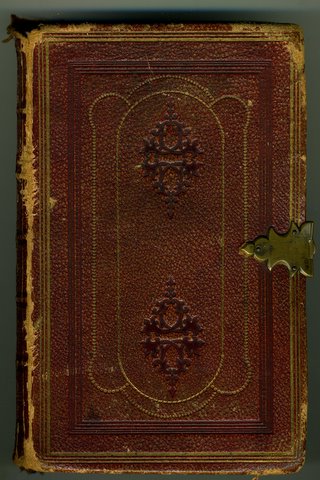
Written inside the front cover and on the first flyleaf, however, are remarkable notes left by two previous owners. The first recounts the travels of G.E.O. throughout the American west during the mid 19th century.
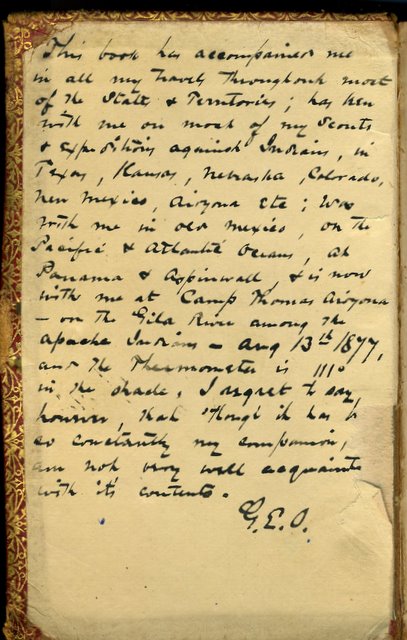
On the flyleaf is a note in pencil, perhaps written by the former owner’s son, of his own travels through Europe and metropolitan U.S., taking the travel Bible with him.
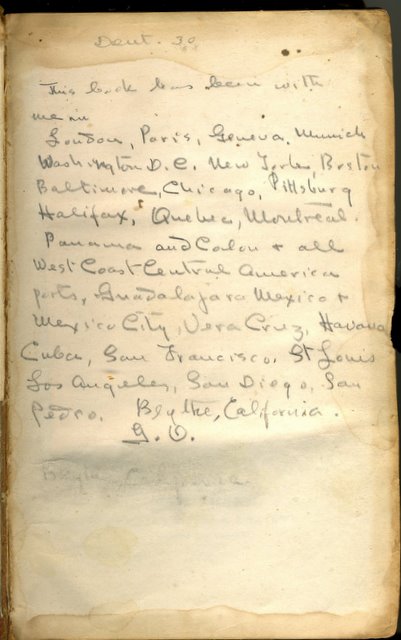
Call number Honnold Special Collections BS 185 1856 N43
Designed by Merle Armitage–Exhibition on view through Feb 1, 2010
On view through February 1 at Honnold/Mudd Library are books from the special collections at Honnold and Denison libraries designed by avant-garde book designer Merle Armitage (1893–1975), one of California’s leading advocates of modern culture.
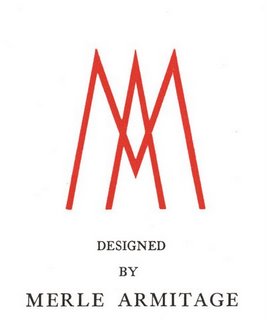
Armitage designed more than forty books for which he wrote essays and/or edited; he designed more than sixty books for other authors and had a long affiliation with New York publishers Weyhe and Duell, Sloan, and Pearce. When he “retired”, Armitage moved to Yucca Valley, California, where he continued to write, design, and publish books under the imprint Manzanita Press until his death in 1975.
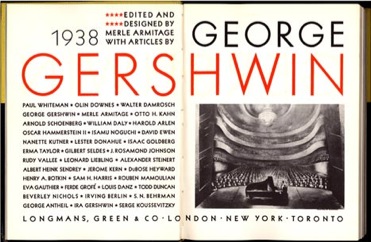
Armitage knew and authored books about some of the finest artists of the century, among them Igor Stravinsky, Martha Graham, George Gershwin, Pablo Picasso, and Rockwell Kent, to name a few. A participant in the circle of artists and writers surrounding local rare-book dealer Jake Zeitlin, Armitage supported the work of his friends such as Edward Weston and Ramiel Mcgehee. Armitage authored and designed the first published monograph about Edward Weston. Scholars have written of Armitage’s background in artist promotion as the beginning of his life-long interest in re-imagining– and innovating –the design of printed books for the modern age.
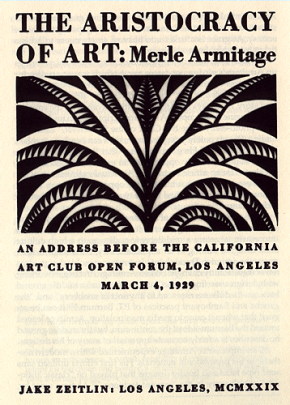
In Notes on Modern Printing, Armitage offers eleven ideas for designing a book; of these ideas, number six is a good summary of his aesthetic: “Understand the text…know your primary aims…let form follow function.”
Goodbye 2009
and hello 2010.
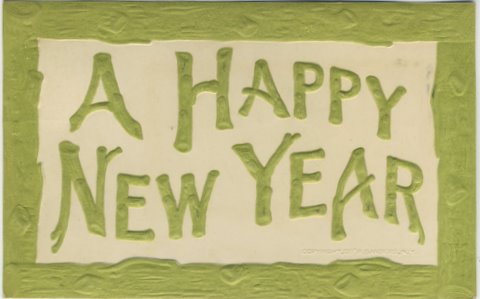
from a postcard album created by a member of the James Blaisdell family, held in the Pomona College Archives in Special Collections, Honnold/Mudd Library.
Add Special Collections New Acquisitions to Your Blog Reader
Find out what we’re cataloging in Special Collections by subscribing to our RSS feed. We hope you find this service useful.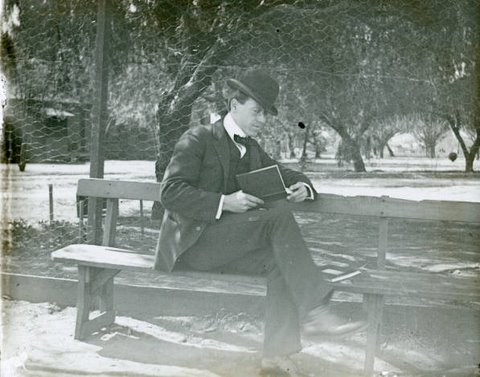
Pomona College student, circa 1900
Noticias de la Nueva California by Rev. Padre Fr. Francisco Palou (1874)
New in Special Collections is the 1874 California edition of Noticias de la Nueva California by Fr. Francisco Palou (San Francisco, Imprenta de Edouardo Boxqui y Cia, 1874). Ours is number 17 of 100 copies, numbered and initialed by John T. Doyle, who wrote the introduction. Printed in four parts, Special Collections’ copy is bound in two volumes. Noticias is a comprehensive source book on the histories of the California missions from 1767 to 1784.
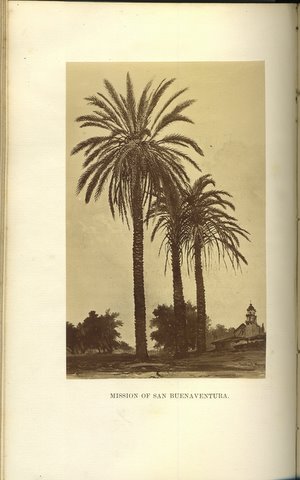
Part one, tipped in after page 192
Padre Francisco Palou, a Franciscan priest, missionary, and close colleague and friend of Fr. Junipero Serra, is called by some ‘the father of California history’ because of the depth and breadth of the primary sources that he gathered and reproduced in Noticias.
Most notable in this edition are the eighteen mounted albumen photographs and is one of only 21 California books illustrated with original photographs before 1890. Some of the photographs relate to San Diego and include a city view, San Diego Mission, Commercial Bank of San Diego, and olive orchard and palms at the Mission; others are of Mission Santa Barbara, Mission San Carlos, the old customs house San Francisco. The photographs were taken by prominent photographers, including Bradley & Rulofson, John R. Jarboe, E.J. Muybridge, and W.W. Stewart.
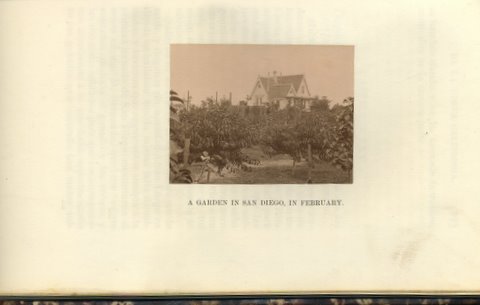
Part two, tipped in after page 272
French Missal, Crispin 12
Crispin 12 is a missal, a service book containing texts for performing the mass, copied in France in the mid 1400s for John III de la Rochefoucauld, bishop of Mende and thirtieth abbot of St. Amant-de-Boixe, in the diocese of Angoulême. De la Rochefoucauld’s arms, or a cross gules, supported by two angels, appears in the lower margin of the image below.
This illumination depicting the symbols of the Evangalists, based on John’s vision in the Apocolypse–Matthew as Man, Mark as Lion, Luke as Ox, John as Eagle– along with another full-page illumination of the crucifixion of Christ, comprise a bifolium that was added to the manuscript in the early 1600s.
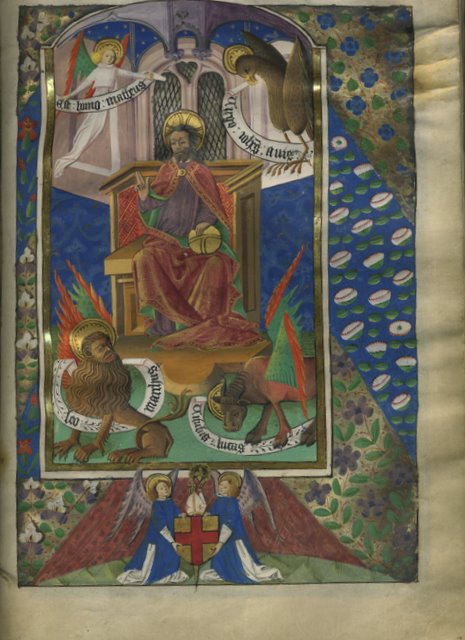
The Crispin Collection of exquisite examples of early bookmaking and fine binding was given to Honnold Library by Dr. Egerton Crispin during the 1950s and early 1960s. Nearly fifty Medieval and Renaissance manuscripts, including 12th century sermons, 13th century Bibles, 14th and 15th century books of hours, missals, psalters and antiphonals are among the contents of the Crispin Collection.
Denison Library on the Scripps College campus, and the library at the Claremont School of Theology also hold significant collections of medieval and renaissance manuscripts. These collections are cataloged definitively in Dutschke and Rouse, Medieval and Renaissance Manuscripts in the Claremont Libraries (University of California Press, 1986), call number Z 6621 .H5814 1986
Alexander Little, His Book (1795-1796)
An interesting and charming bit of 18th century Americana from the historical manuscripts collections at Special Collections, Honnold/Mudd Library: Alexander Little’s “cypheren book”, a manuscript bound in homespun blue cloth, comprising mathematical principles and tables, including financial calculations as well as tables of weights and measures and avoirdupoise. It was created by Little between Nov. 12, 1795 to Aug. 12, 1796, when he was 16 years old, perhaps during an apprenticeship.
The manuscript numbers 26 folded sheets; here are two sample pages:
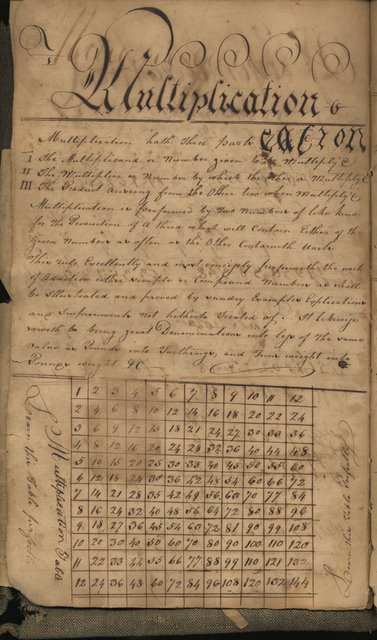
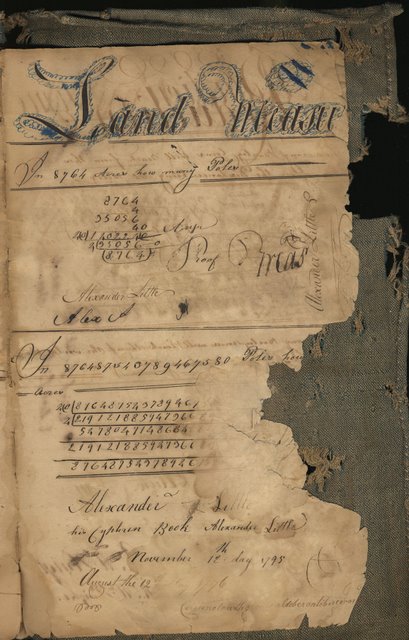
We know a little bit about Alexander Little. He was born February 20, 1779 in Virginia. He married Rachel Robinson, daughter of William and Ann Robinson. At some point, he lived in Mercer County, Kentucky, then moved to Indiana where he died July 26,1849.